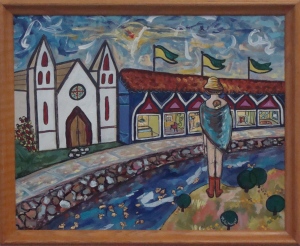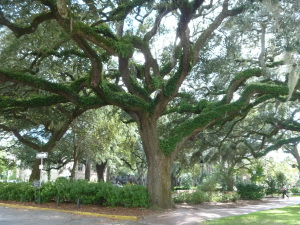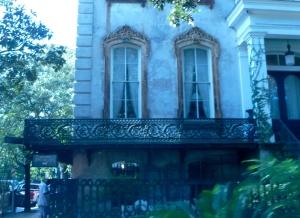 Revisiting Savannah What does this Native woman think as she looks over the Savannah River at a mid-eastern styled shopping center adjacent to an aging church?
Revisiting Savannah What does this Native woman think as she looks over the Savannah River at a mid-eastern styled shopping center adjacent to an aging church?
A Savannah Odyssey This blog is being written because of the plethora of racial issues plastered over the news media. A recent trip to Savannah, Georgia provided me a way to peek under the surface of racial tension. Savannah has approximately 143,000 inhabitants, down from its civil war high of over 200,000. As an outsider it was easier to probe this small eastern city than Portland where I live and have a vested interest in the status quo
I wanted to visit the deep south ever since I read The Prince of Tides by Pat Conroy, and finally got a chance to do so. Last fall, in shared celebration of our birthdays, my cousin Elaine and I ventured forth. My before image was filled with antebellum mansions, wrought iron gates, cotton plantations, trees laden with sphagnum moss and graceful women with lilting southern accents.
It surprised me w hen most of those visions were shattered. Trees dripping with moss were certainly amazing. Big gnarly Oak branches made me want to age regress to a more limber childhood when climbing could be done with ease. I conjured images of being gracefully perched on a long-roped swing while my beau gently pushed me to and fro. The city plan established in 1733 by its founder James Oglethorpe is unique in that streets in the central area are organized around 24 squares or parks, each surrounded by eight blocks for living and shopping. Though the parks no longer are used for grazing cattle, they do offer areas for strolling and listening to folk artists under broad-leafed trees. Rows of closely built homes are embellished with fanciful wrought iron banisters and fences, and churches of every denomination are liberally sprinkled throughout. Those walking the streets were for the most part white and came from all parts of the world, so the southern accents I listened for were sparse. People of color lived in poor ghettos on the outskirts of town.
hen most of those visions were shattered. Trees dripping with moss were certainly amazing. Big gnarly Oak branches made me want to age regress to a more limber childhood when climbing could be done with ease. I conjured images of being gracefully perched on a long-roped swing while my beau gently pushed me to and fro. The city plan established in 1733 by its founder James Oglethorpe is unique in that streets in the central area are organized around 24 squares or parks, each surrounded by eight blocks for living and shopping. Though the parks no longer are used for grazing cattle, they do offer areas for strolling and listening to folk artists under broad-leafed trees. Rows of closely built homes are embellished with fanciful wrought iron banisters and fences, and churches of every denomination are liberally sprinkled throughout. Those walking the streets were for the most part white and came from all parts of the world, so the southern accents I listened for were sparse. People of color lived in poor ghettos on the outskirts of town.
 There are no plantations in Savannah, and there never were any. The invention of the cotton gin by Eli Whitney made it easy to remove seeds from cotton fiber, and that innovation along with new manufacturing techniques led to a flourishing cotton trade. When steamships became practical in the early 1800s the city blossomed as an export and importing hub.
There are no plantations in Savannah, and there never were any. The invention of the cotton gin by Eli Whitney made it easy to remove seeds from cotton fiber, and that innovation along with new manufacturing techniques led to a flourishing cotton trade. When steamships became practical in the early 1800s the city blossomed as an export and importing hub.
In 1861 the white ruling class celebrated the state’s decision to secede from the Union. They were determined to maintain their lifestyle by keeping just under half of the population enslaved. Four grueling years ended in 1864 when Sherman captured Savannah. White and black alike welcomed an end to the carnage that wrecked their lives and killed their sons and husbands. The power elite adapted easily to the end of slavery by planning a new economy that maintained the status quo. For over one hundred years the white population managed to keep control and stave off ambitions of black residents who had fought so bitterly for their rights.
Tourism videos describe Savannah as racially integrated, and several museums and historical houses proudly display exhibitions of art produced by black artists. “Great,” I thought, “ a city with an appreciation for color.” Orgelthorpe did not like slavery, and early on Georgia actually banned the trade. But before long there was not enough manpower to clear the land and do the work, so slaves were imported from South Carolina. With the repeal in 1750 of the anti-slavery law the local economy grew. Savannah become a major port for the slave trade, as well as an export site for cotton, rice and lumber. Interestingly, in 1798 the city again banned slavery, though costal Georgian waterways continued to be used for the trade until 1858.
Being curious, I asked people I met about race relations today. Those of color (making up 55% of the city) responded that everyone coexisted extremely well. With a bit more probing I discovered that men who succeeded, like Supreme Court Justice Clarence Thomas, were few and far between. Though schools and lunch counters are integrated, the 2010 US census shows a city that ranked 6th in the percentage (26%) of people living in poverty, and most of them are African-American. Our hotel workers and taxi cab drivers had told us what they thought we tourists would want to hear. A more honest assessment was given by a white guide who answered with rancor, “What do you expect? This is the south.”
Though the Food Network distanced itself from Paula Deen because of racial slurs made on national television, she still remains the queen of Southern cuisine and her restaurant flourishes. Political gains have not translated to economic equality, and white faces remain in tourist areas and in the nicer parts of town. Increases in violence, teen-age pregnancy and drug abuse are alarming to local residents. African-American business activity is collapsing and unemployment is twice that of the white population . . . just as it was in the 1960’s.
Change continues to visit the city in unexpected ways. Stores with middle eastern influences were erected on the main shopping street, breaking the historic feel of center city. There are a wide variety of ethnic restaurants to lure a hungry appetite, but fried chicken and macaroni and cheese remain supreme. I admit, they are delicious and a good excuse to stop calorie counting.
When the civil rights movement called for reform, colored and white-only bathrooms were finally eliminated. Yet in reaction to desegregated schools, 10,000 parents pulled their children out of the newly integrated system and sent them to private institutions. Today 18% of the county’s children do not receive a public education, a much higher number than in other Georgian counties. There are a smattering of hopeful signs within the school system, though. With the recent introduction of magnet schools, sections of the city are reversing the outgoing trend. An example is Ardsley Park that boasts a new Montessori magnet program.
Cities throughout the United States are bubbling with fermented hatred, and it takes a great amount of investigation to uncover truths. It is difficult to make sense of political manipulations, and very laborious to develop a plan that works for all. In my home town, I rarely talk to anyone about racial issues, though I would welcome a forum for doing so. Many our city’s racial problems are similar to those found in Savannah. Poverty, poor health, ghetto housing, drugs, lack of education and few employment opportunities rack most urban areas. If newscasters focused on these issues rather than give in to sensationalism, perhaps a more effective dialogue could be started, and we might end the cycle of shootings between police and racially profiled targets.
For more information go to:http://savannahnow.com/features/reseg/RESEG5/inside5/main5.html – White Flight
http://savannahnow.com/features/reseg/RESEG5/inside5/main5.html – Savannah schools
http://www.nytimes.com/1991/08/08/us/jim-crow-s-ghost-savannah-civil-rights-special-report-ways-older-south-linger.html – The segregated Savannah.
http://www.georgiaencyclopedia.org/articles/history-archaeology/atlantic-slave-trade-savannah – about Slavery in Savannah and Georgia.
http://www.examiner.com/article/4th-of-july-2013-and-notes-on-race-and-racism-savannah-georgia-part-3-of-3 – Race relations in Savannah.
http://www.ajc.com/news/business/deen-still-a-draw-in-savannah/nYYdJ/#__federated=1 – about Paula Dean.
http://www.ourdocuments.gov/doc.php?flash=true&doc=14 – Statistics
Home » Blog » Savannah Odyssey
Table of Contents
A Savannah Odyssey This blog is being written because of the plethora of racial issues plastered over the news media. A recent trip to Savannah, Georgia provided me a way to peek under the surface of racial tension. Savannah has approximately 143,000 inhabitants, down from its civil war high of over 200,000. As an outsider it was easier to probe this small eastern city than Portland where I live and have a vested interest in the status quo
I wanted to visit the deep south ever since I read The Prince of Tides by Pat Conroy, and finally got a chance to do so. Last fall, in shared celebration of our birthdays, my cousin Elaine and I ventured forth. My before image was filled with antebellum mansions, wrought iron gates, cotton plantations, trees laden with sphagnum moss and graceful women with lilting southern accents.
It surprised me w hen most of those visions were shattered. Trees dripping with moss were certainly amazing. Big gnarly Oak branches made me want to age regress to a more limber childhood when climbing could be done with ease. I conjured images of being gracefully perched on a long-roped swing while my beau gently pushed me to and fro. The city plan established in 1733 by its founder James Oglethorpe is unique in that streets in the central area are organized around 24 squares or parks, each surrounded by eight blocks for living and shopping. Though the parks no longer are used for grazing cattle, they do offer areas for strolling and listening to folk artists under broad-leafed trees. Rows of closely built homes are embellished with fanciful wrought iron banisters and fences, and churches of every denomination are liberally sprinkled throughout. Those walking the streets were for the most part white and came from all parts of the world, so the southern accents I listened for were sparse. People of color lived in poor ghettos on the outskirts of town.
hen most of those visions were shattered. Trees dripping with moss were certainly amazing. Big gnarly Oak branches made me want to age regress to a more limber childhood when climbing could be done with ease. I conjured images of being gracefully perched on a long-roped swing while my beau gently pushed me to and fro. The city plan established in 1733 by its founder James Oglethorpe is unique in that streets in the central area are organized around 24 squares or parks, each surrounded by eight blocks for living and shopping. Though the parks no longer are used for grazing cattle, they do offer areas for strolling and listening to folk artists under broad-leafed trees. Rows of closely built homes are embellished with fanciful wrought iron banisters and fences, and churches of every denomination are liberally sprinkled throughout. Those walking the streets were for the most part white and came from all parts of the world, so the southern accents I listened for were sparse. People of color lived in poor ghettos on the outskirts of town.
In 1861 the white ruling class celebrated the state’s decision to secede from the Union. They were determined to maintain their lifestyle by keeping just under half of the population enslaved. Four grueling years ended in 1864 when Sherman captured Savannah. White and black alike welcomed an end to the carnage that wrecked their lives and killed their sons and husbands. The power elite adapted easily to the end of slavery by planning a new economy that maintained the status quo. For over one hundred years the white population managed to keep control and stave off ambitions of black residents who had fought so bitterly for their rights.
Tourism videos describe Savannah as racially integrated, and several museums and historical houses proudly display exhibitions of art produced by black artists. “Great,” I thought, “ a city with an appreciation for color.” Orgelthorpe did not like slavery, and early on Georgia actually banned the trade. But before long there was not enough manpower to clear the land and do the work, so slaves were imported from South Carolina. With the repeal in 1750 of the anti-slavery law the local economy grew. Savannah become a major port for the slave trade, as well as an export site for cotton, rice and lumber. Interestingly, in 1798 the city again banned slavery, though costal Georgian waterways continued to be used for the trade until 1858.
Being curious, I asked people I met about race relations today. Those of color (making up 55% of the city) responded that everyone coexisted extremely well. With a bit more probing I discovered that men who succeeded, like Supreme Court Justice Clarence Thomas, were few and far between. Though schools and lunch counters are integrated, the 2010 US census shows a city that ranked 6th in the percentage (26%) of people living in poverty, and most of them are African-American. Our hotel workers and taxi cab drivers had told us what they thought we tourists would want to hear. A more honest assessment was given by a white guide who answered with rancor, “What do you expect? This is the south.”
Though the Food Network distanced itself from Paula Deen because of racial slurs made on national television, she still remains the queen of Southern cuisine and her restaurant flourishes. Political gains have not translated to economic equality, and white faces remain in tourist areas and in the nicer parts of town. Increases in violence, teen-age pregnancy and drug abuse are alarming to local residents. African-American business activity is collapsing and unemployment is twice that of the white population . . . just as it was in the 1960’s.
Change continues to visit the city in unexpected ways. Stores with middle eastern influences were erected on the main shopping street, breaking the historic feel of center city. There are a wide variety of ethnic restaurants to lure a hungry appetite, but fried chicken and macaroni and cheese remain supreme. I admit, they are delicious and a good excuse to stop calorie counting.
When the civil rights movement called for reform, colored and white-only bathrooms were finally eliminated. Yet in reaction to desegregated schools, 10,000 parents pulled their children out of the newly integrated system and sent them to private institutions. Today 18% of the county’s children do not receive a public education, a much higher number than in other Georgian counties. There are a smattering of hopeful signs within the school system, though. With the recent introduction of magnet schools, sections of the city are reversing the outgoing trend. An example is Ardsley Park that boasts a new Montessori magnet program.
Cities throughout the United States are bubbling with fermented hatred, and it takes a great amount of investigation to uncover truths. It is difficult to make sense of political manipulations, and very laborious to develop a plan that works for all. In my home town, I rarely talk to anyone about racial issues, though I would welcome a forum for doing so. Many our city’s racial problems are similar to those found in Savannah. Poverty, poor health, ghetto housing, drugs, lack of education and few employment opportunities rack most urban areas. If newscasters focused on these issues rather than give in to sensationalism, perhaps a more effective dialogue could be started, and we might end the cycle of shootings between police and racially profiled targets.
For more information go to:http://savannahnow.com/features/reseg/RESEG5/inside5/main5.html – White Flight
http://savannahnow.com/features/reseg/RESEG5/inside5/main5.html – Savannah schools
http://www.nytimes.com/1991/08/08/us/jim-crow-s-ghost-savannah-civil-rights-special-report-ways-older-south-linger.html – The segregated Savannah.
http://www.georgiaencyclopedia.org/articles/history-archaeology/atlantic-slave-trade-savannah – about Slavery in Savannah and Georgia.
http://www.examiner.com/article/4th-of-july-2013-and-notes-on-race-and-racism-savannah-georgia-part-3-of-3 – Race relations in Savannah.
http://www.ajc.com/news/business/deen-still-a-draw-in-savannah/nYYdJ/#__federated=1 – about Paula Dean.
http://www.ourdocuments.gov/doc.php?flash=true&doc=14 – Statistics
Table of Contents